All Management Events
- How to craft your first Research Paper! September 28, 2022
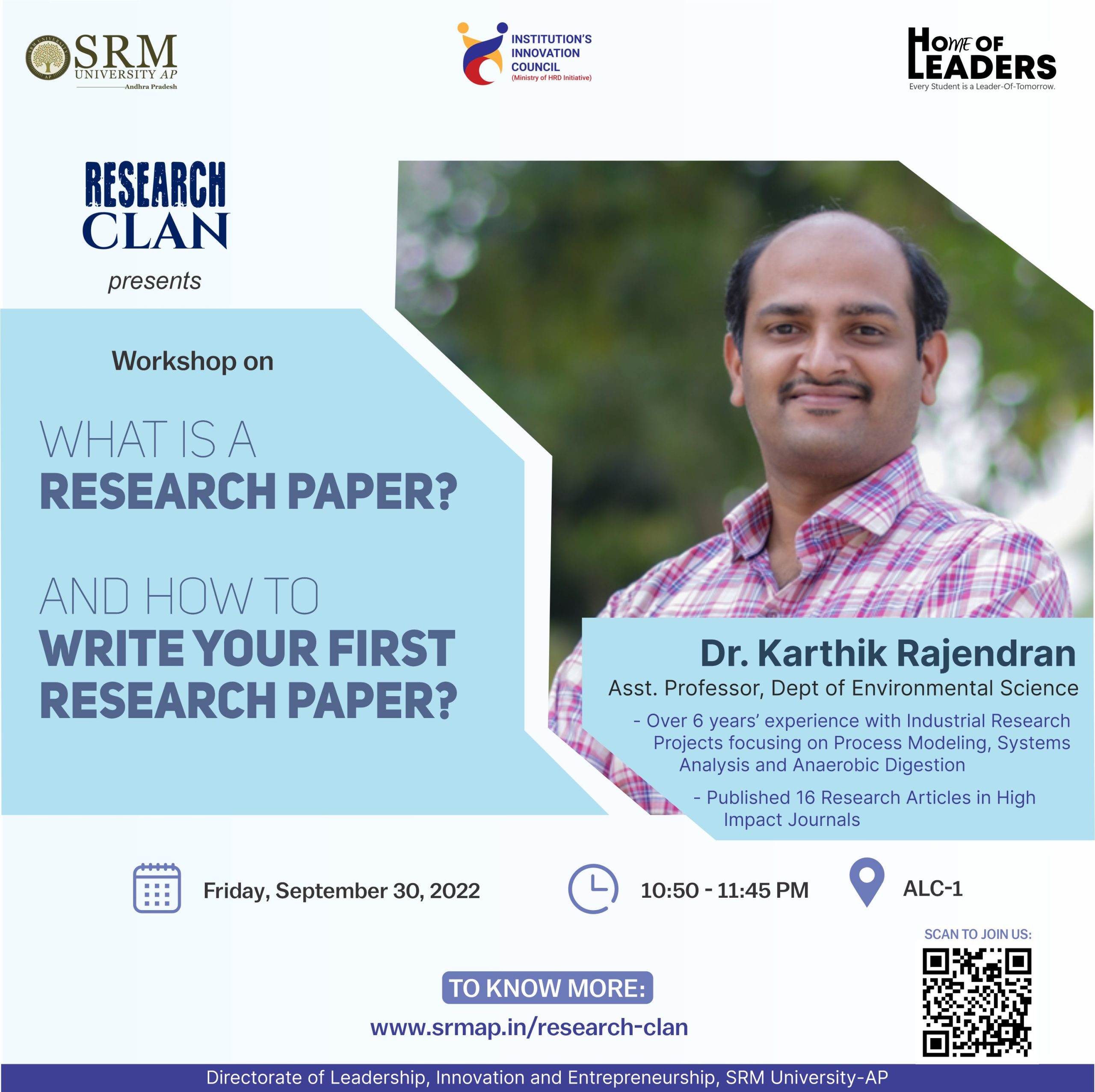 Propagating a novel finding to a general or focused audience requires an appropriate medium. Research papers serve this purpose by popularising your ideas and preventing them from duplication by a third party. They provide analysis, interpretation, and evaluation of anything and everything based on in-depth independent research. However, many research enthusiasts do not have a clear picture of how to craft a solid research paper. Research Clan, an initiative of the Department of Entrepreneurship and Innovation, is back with an exciting workshop on What is a research paper and how to write your first research paper. Dr Karthik Rajendran, Assistant Professor, Department of Environmental Science, will be guiding the students in writing an impactful research paper.
Propagating a novel finding to a general or focused audience requires an appropriate medium. Research papers serve this purpose by popularising your ideas and preventing them from duplication by a third party. They provide analysis, interpretation, and evaluation of anything and everything based on in-depth independent research. However, many research enthusiasts do not have a clear picture of how to craft a solid research paper. Research Clan, an initiative of the Department of Entrepreneurship and Innovation, is back with an exciting workshop on What is a research paper and how to write your first research paper. Dr Karthik Rajendran, Assistant Professor, Department of Environmental Science, will be guiding the students in writing an impactful research paper.Date: September 30, 2022
Time: 10.50 AM to 11.45 AM
Venue: ALC 1
About the speaker
Dr Karthik Rajendran has over 6 years of experience with industrial research projects focusing on Process Modelling, Systems Analysis, and Anaerobic Digestion. He has published several papers, book chapters, books, news articles, etc., in renowned Q1 journals and under various publishing houses. He has held various positions including the Editorial Board Member of Carbon Resources Conversion, Director of the Institute of Chartered Waste Managers, Outstanding reviewer of Energy, Conversion, and Management, etc.
A research paper is the first step on the journey to discovering something new. Join the workshop if you are willing to wander on this path of finding the unknown!
Continue reading → - Get set for the Global Immersion programmes September 28, 2022
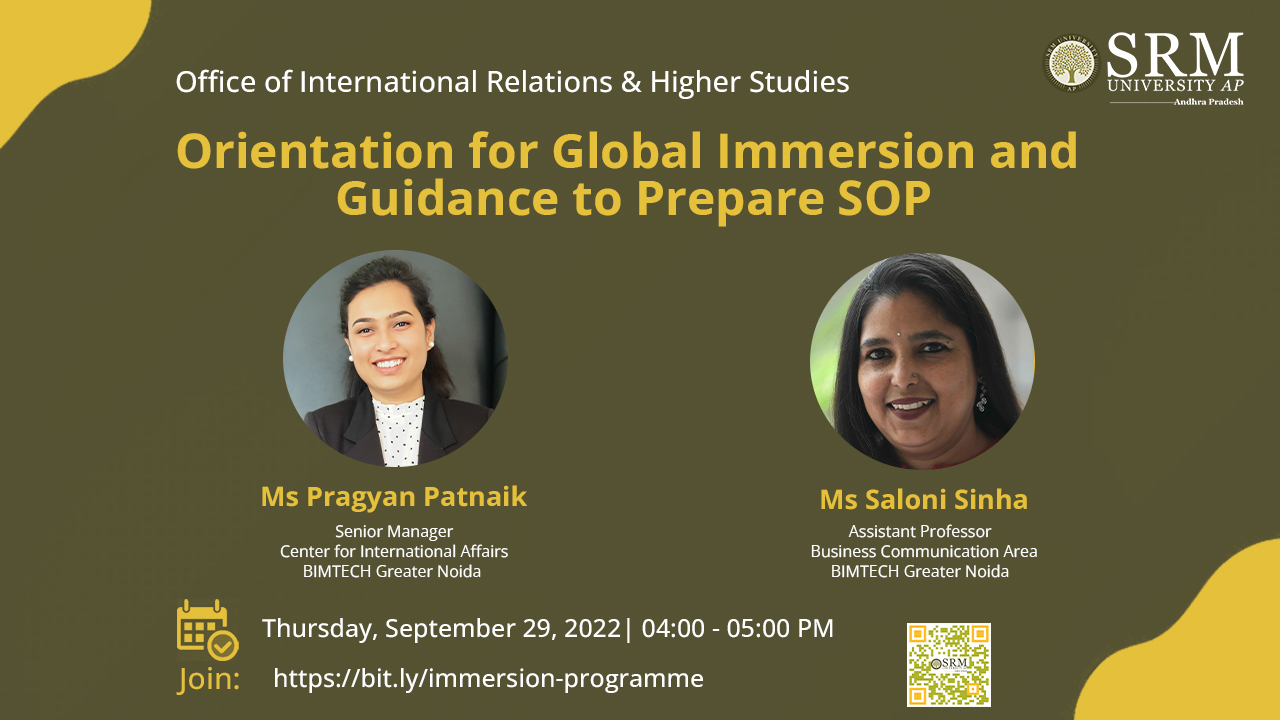
The Office of International Relations and Higher Studies is organising a session titled Orientation for Global Immersion and Guidance to Prepare SOP to enable students to lay the groundwork for their abroad learning programmes with a resounding Statement of Purpose. Ms Saloni Sinha and Ms Pragyan Patnaik from the Birla Institute of Management Technology will address the gathering.
Date: September 29, 2022
Time: 4.00 pm to 5.00 pm
A Statement of Purpose (SOP) is one of the most substantial pieces of evidence to facilitate your abroad learning. The clarity it exudes will define your needs and goals in pursuing the programme. Unfortunately, students are struggling to put together an SOP owing to their lack of clarity in drafting the document. This session intends to cast light on all the prerequisites for abroad education and will train students to compose a convincing SOP.
Speakers’ Profile
Ms Saloni Sinha is a faculty of Communication & Future Skills at the Birla Institute of Management Technology, India. She is a gold medallist in Linguistics from Jawaharlal Nehru University, New Delhi. She works in the domain of enhancing capabilities through her innovative teaching in the field of Communication, Theatre, Future skills, development communication and Intercultural Communication. Her research interests include employability skills, innovative classroom pedagogy, intercultural communication, corporate communication, development communication, education technology and translation. Ms Saloni has recently developed a novel SINHA’s COVID SEL 5X7 Matrix, a socio-emotional learning framework for educators. She is the recipient of the Youth Icon Award 2018 for her Theatre for Social Change initiatives. Ms Saloni is also empanelled as a casual translator in the Prime Minister’s Unit at the Press Information Bureau of the Government of India.
Ms Pragyan Patnaik takes an active interest in the Internationalisation of Higher Education Institutions. With more than a decade of international experience, her stint in the field began during her time as a Researcher in one of the leading Institutes of Technology in Germany – Leibniz University Hannover, in 2010. She has served in the field of Internationalisation of HEIs in various capacities in leading German universities, establishing academic and cultural bridges between India and Germany. She is the recipient of the prestigious Deutscher Akademischer Austauschdienst (DAAD) Fellowship, Germany. Prior to BIMTECH, she served with a premier Indian institution and was responsible for developing the University’s International Relations Office and leading international programs.
Continue reading → - Marquee offer of CTC 26.50 LPA: Srilekha entering a brand new arena of success September 28, 2022
 Addepalli Srilekha from the Department of Computer Science and Engineering is excited to step into a new phase of life with her incredible marquee offer of CTC 26.50. She is placed at Paypal, an American multinational fin-tech company that operates an online payments system that supports online money transfers. She is selected for the position of data scientist, where she will work for the Resolutions and Protections Team.
Addepalli Srilekha from the Department of Computer Science and Engineering is excited to step into a new phase of life with her incredible marquee offer of CTC 26.50. She is placed at Paypal, an American multinational fin-tech company that operates an online payments system that supports online money transfers. She is selected for the position of data scientist, where she will work for the Resolutions and Protections Team.She had the assistance of the Directorate of Corporate Relations and Career Services at every stage of her placement journey. Constant support and guidance were given to the students and different sessions were held in an organised manner which covered various aspects such as coding, interview handling skills, Resume building sessions, etc. One-on-one feedback sessions were also conducted by the placement panel, which was extremely helpful for the students.
Srilekha always wanted to work in data science, so she began her training with Python, SQL, Excel, and a few data visualisation courses. She has consistently learned all the fundamental concepts of computer science, such as data structures, operating systems, and database management systems. She also participated in Competitive Coding Contests from the beginning, which helped her develop an interest in coding and problem-solving. To learn the fundamental concepts, she used to refer to University materials and a few online resources. She has also done much hands-on coding and regularly applied the theoretical knowledge she gained.
The training received at SRM University- AP was highly relevant, timely, and beneficial for Srilekha. For students at various levels, various types of training were provided. “There is always the possibility of starting from scratch here. Daily technical assessments helped us understand the industrial standards and requirements”, said Srilekha as she recollected her training days. Company-specific tests were also administered, and regular alum connect sessions were organised to assist students in understanding the organisations’ recruitment and operations.
She is thankful to Dr Jatindra Kumar Dash, Dr Murali Krishna Enduri, and Dr Priyanka S for their excellent teaching, which was a great help for her during the placement season. “Dr Jatindra Kumar Dash greatly aided my understanding of Machine Learning Algorithms. Because of his guidance, I was able to answer every ML-related question in the interviews”, said Srilekha with gratitude. The classes she took helped enhance her subject knowledge and gain hands-on experience.
She studied FLAT and Compiler Design for two semesters under Dr Murali Krishna Enduri. This subject helped her understand the insights of Automata theory and the structural workings of compilers. These two subjects are Srilekha’s favorites solely because of Dr Murali Krishna Enduri. Dr Priyanka S taught her two crucial subjects that played a significant role in the placement season: Introduction to Python and Operating Systems. Her classes were very organised, and the teaching strategies were very effective.
Srilekha aspires to come up with new ideas and innovations at her workplace and climb up the ladder of her career with determination and hard work.
Continue reading → - Community training on Hands-Only CPR September 27, 2022

SRM University-AP, in collaboration with AIIMS Mangalagiri and the American Heart Association, is organising a Community Training on Hands-Only CPR on September 29, 2022, World Heart Day. Heart health is a fundamental human right and an essential component of global health justice.
World Heart Day was established by the World Heart Federation to educate people around the world that cardiovascular disease (CVD), including heart disease and stroke, is the leading cause of death in the world. The campaign highlights the actions that individuals can take to prevent and control CVD. It tries to motivate individuals to take action by educating them about how risk factors such as cigarette use, poor diet, and physical inactivity can prevent at least 80% of premature deaths from heart disease and stroke.
Cardiopulmonary Resuscitation (CPR) is an emergency lifesaving technique to be performed during instances of cardiac arrest or heart attack, or situations where someone’s heartbeat has stopped. CPR can double or triple the chances of survival after cardiac arrest. The American Heart Association is the leader in resuscitation science, education, and training and the publisher of the official Guidelines for CPR and ECC.
Learning Hands-Only CPR is learning an essential skill that would enable you to save a life!
Continue reading → - Career after engineering: a useful guide for your future September 26, 2022
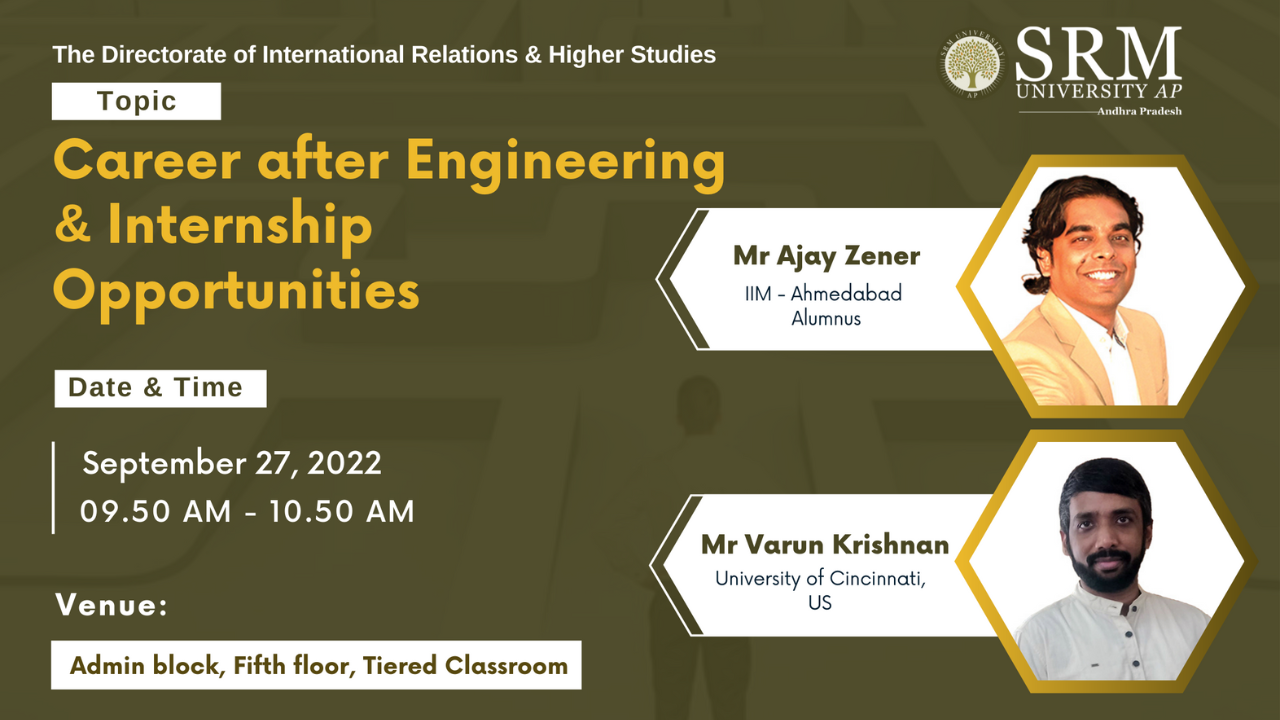 Engineering became a prominent career option over the past decades with the life-changing impacts it had on the common people’s world. It has a huge hand in making our lives easier with evolving technology and expanding innovations. The Directorate of International Relations and Higher Studies is hosting a seminar on Career after Engineering & Internship opportunities to discuss the possibilities of the disciplines in an elaborate manner. Renowned career mentor Mr Ajay Zener and SRM Alumni Mr Varun Krishnan will be interacting with the students.
Engineering became a prominent career option over the past decades with the life-changing impacts it had on the common people’s world. It has a huge hand in making our lives easier with evolving technology and expanding innovations. The Directorate of International Relations and Higher Studies is hosting a seminar on Career after Engineering & Internship opportunities to discuss the possibilities of the disciplines in an elaborate manner. Renowned career mentor Mr Ajay Zener and SRM Alumni Mr Varun Krishnan will be interacting with the students.Date: September 27, 2022
Time: 09.50 AM to 10.50 AM
Venue: Admin Block, Fifth Floor, Tiered classroom
About the speakers
Mr Ajay Zener is one of the best career mentors of India who has guided more than 10,000+ students the past 11 years to top universities across the world. He is an Engineering graduate from the National Dairy Research Institute, Karnal, with an MBA degree from IIM Ahmedabad. He has 13 years of work experience in international companies like Cadbury, Nestle and Olam and has worked in over 14 countries. He is working as CAT, GRE, and GMAT Mentor in GradSquare and has won the Brand Icon’s International Excellence Award for Best Career Counsellor in India 2022
Mr Varun Krishnan is an engineering graduate from SRM Institute of Science and Technology, Chennai, and a Mechanical Engineering graduate from the University of Cincinnati, US. He is currently mentoring the GRE, CAT & GMAT students. He handles Admission counseling for GMAT, GRE & GD-PI preparation for MBA students. He has secured 99.72% in CAT 2018, 99.62% in CAT 2019, and 99.78% in CAT 2021.
Join the seminar to get an in-depth understanding of the career opportunities after engineering!
Continue reading → - Dr Syed Tajammul Ahmad September 26, 2022
- Education fair 2022: An exposure to major USA and UK universities September 26, 2022
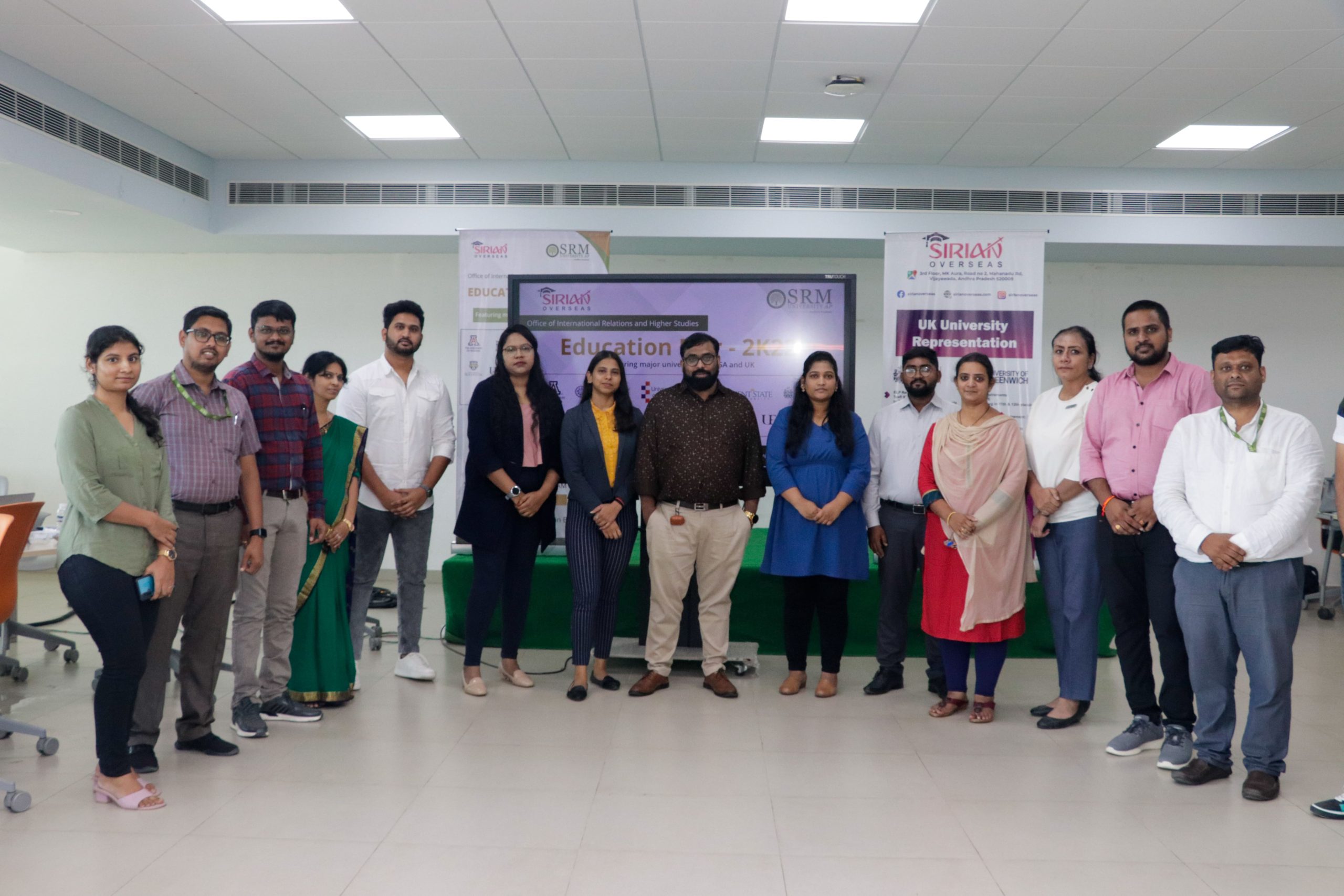 The office of International Relations and Higher Studies hosted the Education Fair on Friday, September 23, 2022, to provide thorough guidance about the higher education universities and programmes available across the globe. The event featured major USA and UK universities, including the University of Rochester, USA, University of Greenwich, UK, University of Essex, UK, University of Arizona, USA, and many more.
The office of International Relations and Higher Studies hosted the Education Fair on Friday, September 23, 2022, to provide thorough guidance about the higher education universities and programmes available across the globe. The event featured major USA and UK universities, including the University of Rochester, USA, University of Greenwich, UK, University of Essex, UK, University of Arizona, USA, and many more.The education fair began with an introduction to study abroad programmes. Students witnessed a detailed PowerPoint presentation on the general aspects of higher education abroad, like the qualifying examinations, VISA, various coaching available, fee waivers, etc. The education fair was conducted to give the students accurate information from the streams they want to choose to the scopes of that streams in a particular state or country.
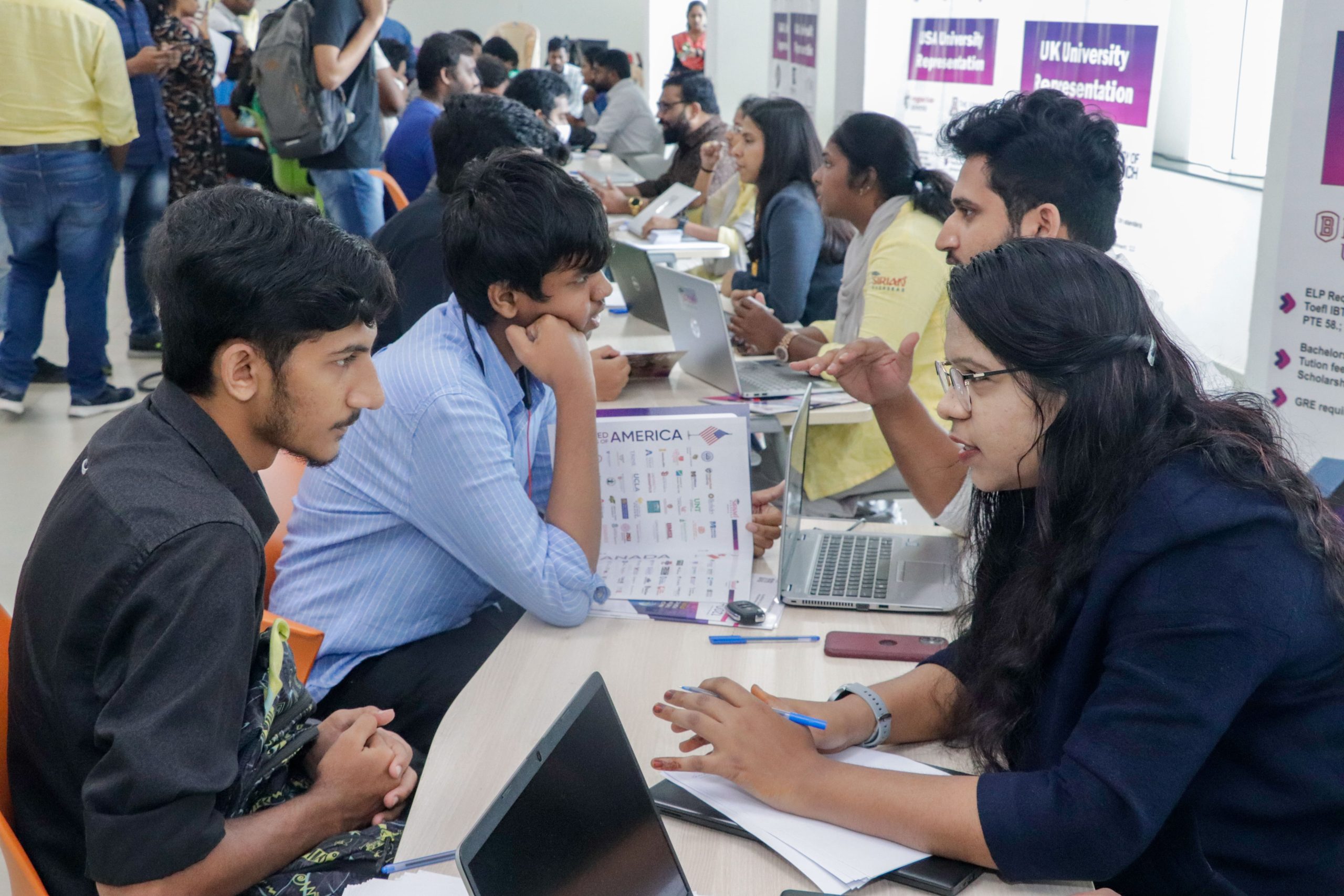 Roop Sagar from BTech CSE also expressed how he had no clarity about the processes, requirements, scholarships, etc., before attending such sessions and was able to get a good picture of his aspirations after interacting with the university representatives. He recollected how the Office of International Relations and Higher Studies has always assisted him with accurate guidance whenever he was in doubt.
Roop Sagar from BTech CSE also expressed how he had no clarity about the processes, requirements, scholarships, etc., before attending such sessions and was able to get a good picture of his aspirations after interacting with the university representatives. He recollected how the Office of International Relations and Higher Studies has always assisted him with accurate guidance whenever he was in doubt.“As someone who wants to pursue higher education by specialising in AI and ML, I am thankful to SRM University- AP for giving exposure to foreign universities that offer affordable courses and internships,” said Yaswanth from BTech CSE as he shared thoughts on the Education Fair.
The representatives of the universities were in awe of students who had done their homework beforehand of the event and were pleased to answer as many questions as possible. “SRM University is one of the leading universities in India, there is no doubt about that, and here we get many students who are extremely talented and are suitable for post-graduation programmes and research,” said Amritpal Kaur, Senior Programme Officer of the University of Rochester.
Continue reading → - An incredible journey to the India Book of Records September 26, 2022
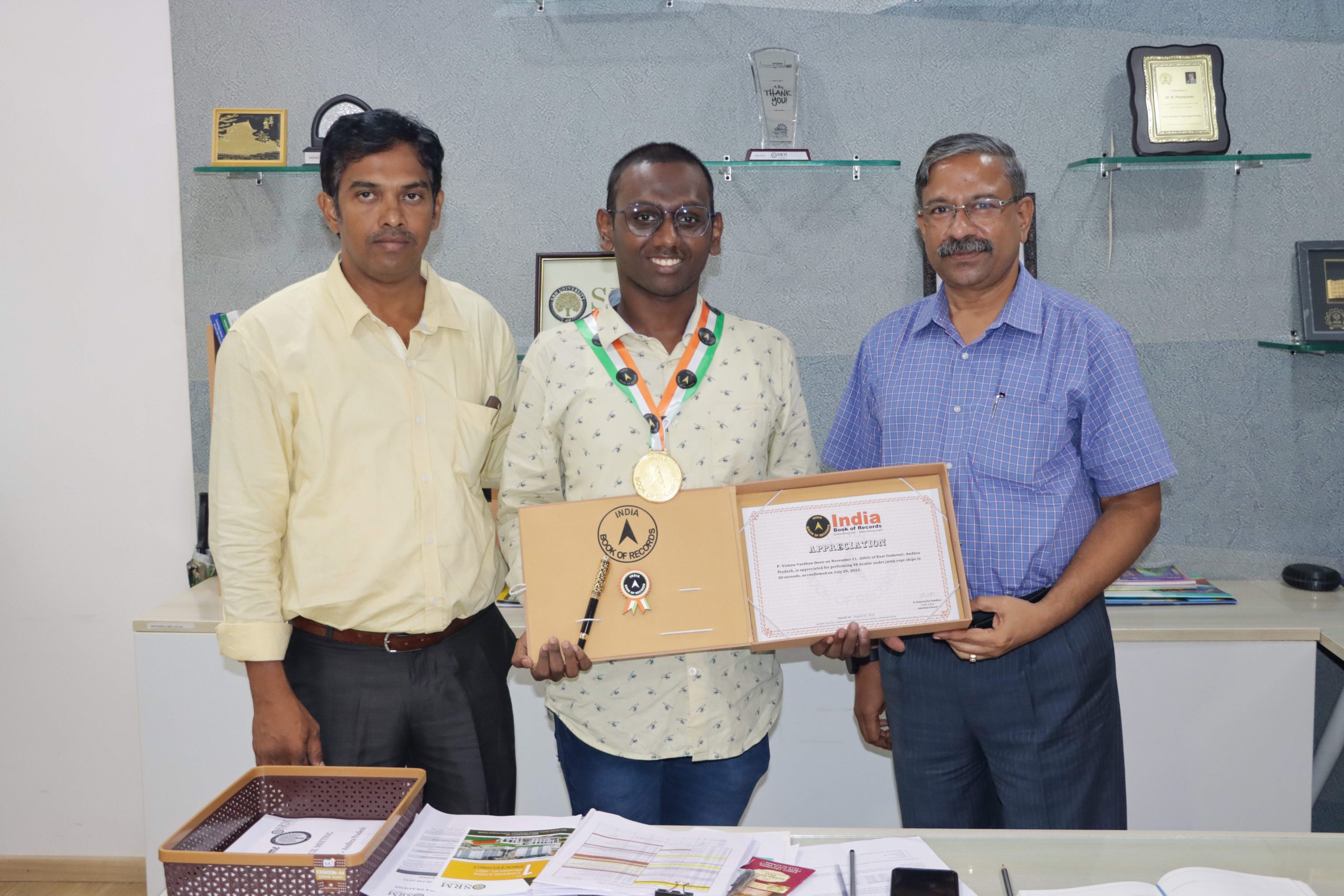
It is a moment of immense pride for SRM University- AP to welcome a new record maker into our midst. P Vishnu Vardhan from the Department of Computer Science Engineering has carved his name into the India Book of Records for performing 48 double-under jump rope skips in 20 seconds. He has also managed to set two records in the National Book of World Records. When most surrender their favourite hobbies to the rush of our work and academic life, this incredible student has displayed hardwork and dedication to transform his hobby into a national record.
Mr Vishnu Vardhan comments on the multiple times he succumbed to giving up his hobby of skipping ropes but realised that it was a space of refuge amidst the pressures of the world. He has shown an incredible feat of courage and dedication to set this impressive record by braving the rejection that he initially had faced.
“When I came to know about the India Book of Records, it was my parents who made me apply for it but I was rejected the first time. I had lost all hope but my friends supported me to pursue my passion for skipping rope and also helped with my academics. Finally I have entered into the National Book of Records, twice and the India Book of Records as well”, he said.
He has extended a heartfelt note towards his parents and his friends, M Surya Teja and K Nithin, for their undying support and confidence that has guided him to attain this amazing achievement.
Mr Vishnu Vardhan hopes to represent SRM University- AP at the All India Inter University rope skipping competition and provide further laurels for the institution. His journey to setting national records proves that with passion, endurance and a generous amount of optimism, even the unachievable could be achieved.
Continue reading → - Awareness on international internships and immersion programmes September 26, 2022
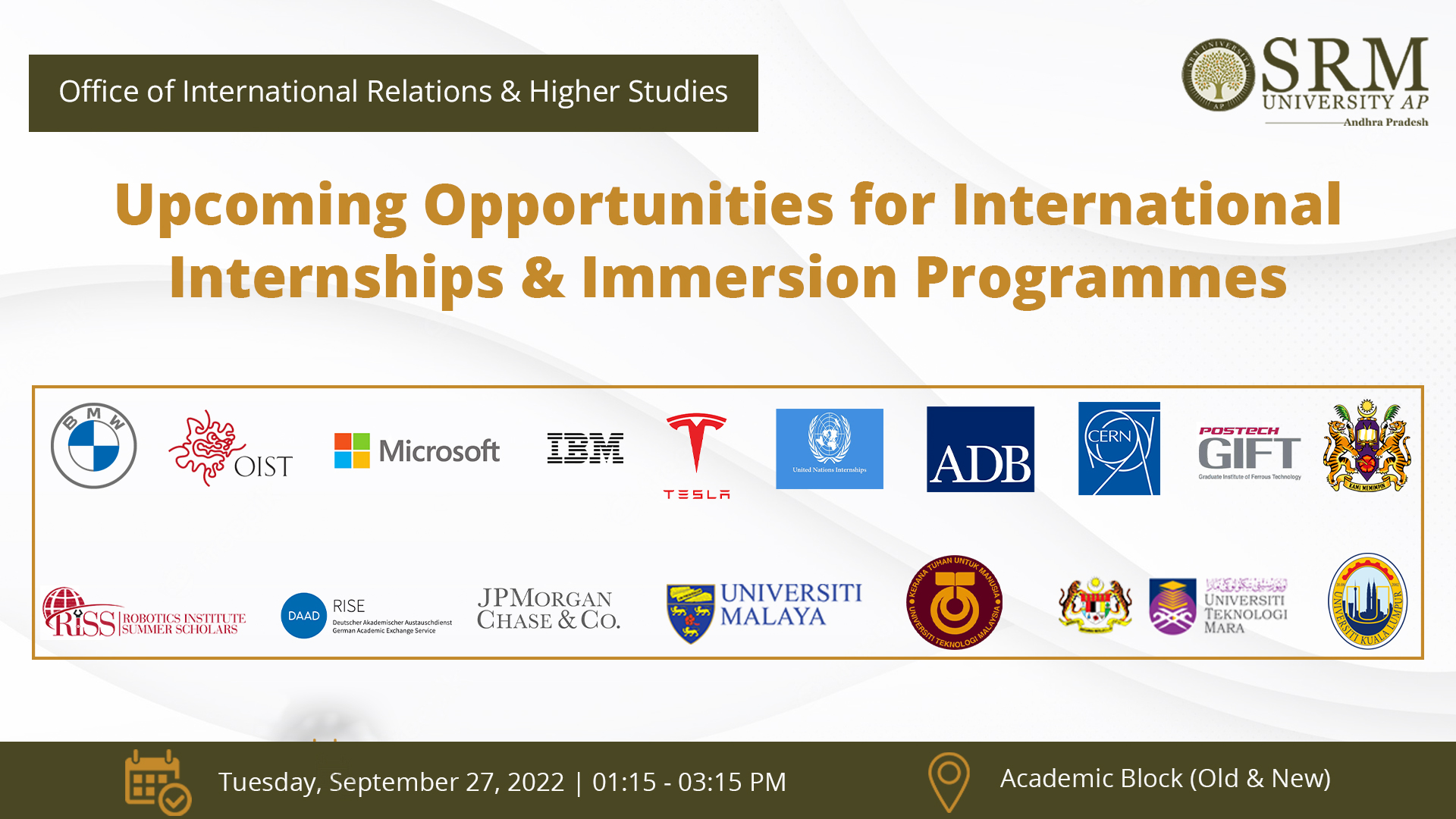
Students are often confused about choosing the right course to attain their dream career. The International Internship and Immersion Programmes enlighten students with the multitude of courses and internships that are at their disposal. The programme guides students on opting the right course beneficial for their future career of choice.
The Office of International Relations and Higher Studies is conducting an awareness programme called Upcoming Opportunities for International Internships & Immersion Programmes for interested students. This initiative provides insight on the preparatory strategy and process for internships and courses at international universities.
Date: 27 September, 2022
Time: 1.15 PM to 3 .15 PM IST
Location: Academic Block (Old & New), Ground Floor
Join the event and initiate your step to global education.
Continue reading → - Students visit Fopple Drone Tech Pvt Ltd September 26, 2022
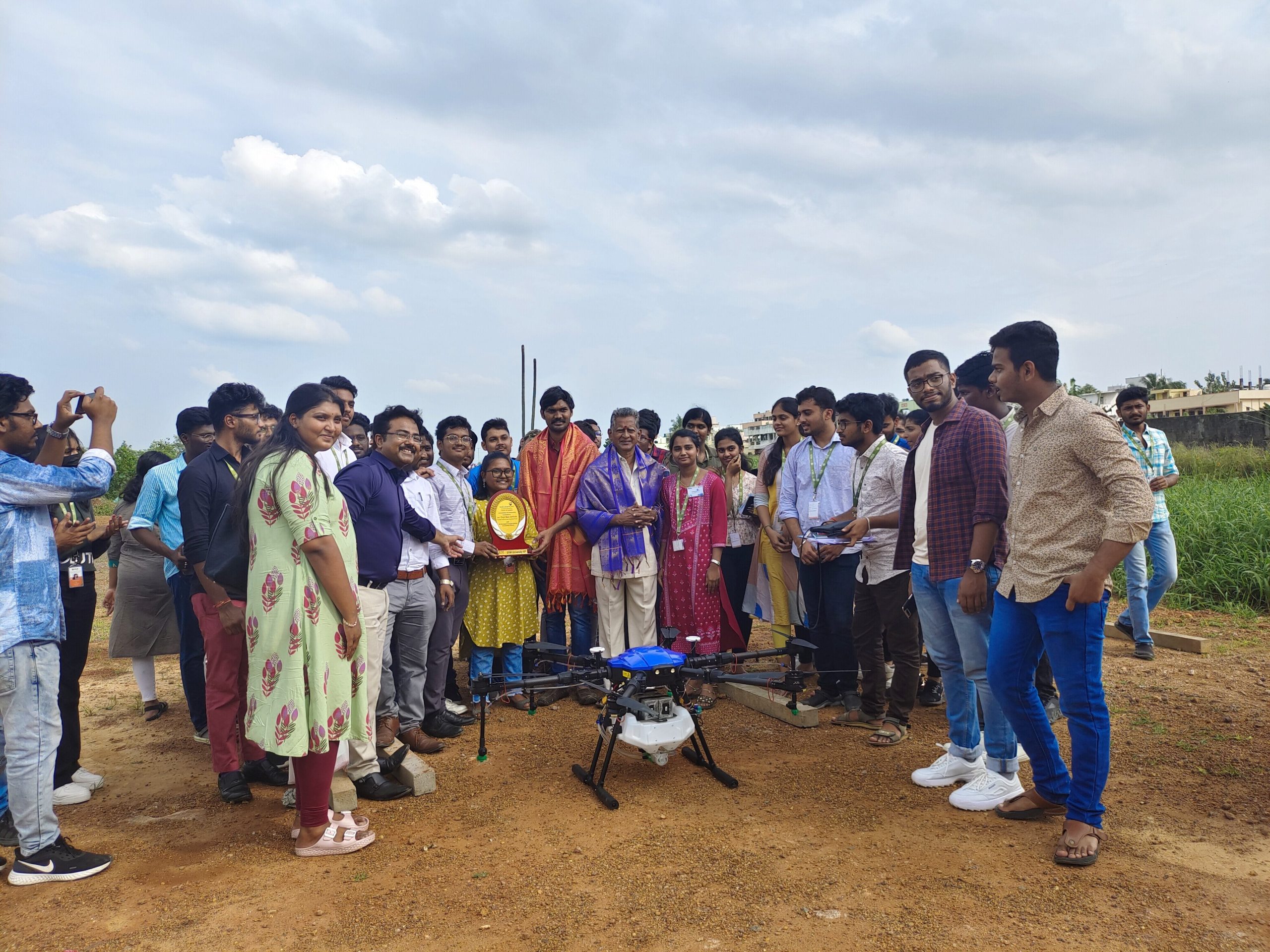
The Directorate of Entrepreneurship and Innovation had conducted an industry visit to Fopple Drone Tech Pvt Ltd, an innovative start-up aiming to revolutionise agricultural machinery. The industry visit that took place on September 20, 2022 was organised by the student community Industree Owl from the Home of Leaders initiative.The participants had the chance to experience the latest drone technology and its various applications in the agricultural industry.
The learning process is never restricted to purely theoretical bounds but associated as being an exploratory and experiential activity. The startup/industrial visit provided students practical exposure to a startup as well as its challenges and first hand experience of what it takes to be a leader, a startup founder or an entrepreneur.
As a part of their visit, the students participated in a boot camp followed by an intense interaction with the farmer community to identify and understand the grassroot problems and the application of technology as a solution. Later, Shri Gopi Raja, the CEO and founder of Fopple Drone Tech Pvt. Ltd addressed the participants and shared his journey to innovation which made a deep impact on the students.The visit came to fruitful end inspiring courage among students to expand their vision and realise their potential to work in the direction of obtaining Atmanirbhar Bharat.
The industrial visit had intended to design a solution and instil inspiration in students to begin a venture in the same domain. After acquiring necessary perceptive, students have reached out to discuss their project ideas which can be commercialised to utilise in the advancement in the field of agriculture. The visit granted a brilliant and insightful exposure to our students on the cutting-edge technology, the scope and the future of India in the next 5 -10 years.
Continue reading →

